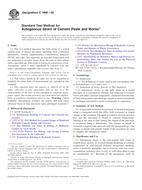Potřebujeme váš souhlas k využití jednotlivých dat, aby se vám mimo jiné mohly ukazovat informace týkající se vašich zájmů. Souhlas udělíte kliknutím na tlačítko „OK“.
ASTM C1698-09
Standard Test Method for Autogenous Strain of Cement Paste and Mortar
Automaticky přeložený název:
Standardní zkušební metoda pro plynové kmene cementové kaše a malty
NORMA vydána dne 1.10.2009
Informace o normě:
Označení normy: ASTM C1698-09
Poznámka: NEPLATNÁ
Datum vydání normy: 1.10.2009
Kód zboží: NS-12240
Počet stran: 8
Přibližná hmotnost: 24 g (0.05 liber)
Země: Americká technická norma
Kategorie: Technické normy ASTM
Anotace textu normy ASTM C1698-09 :
Keywords:
autogenous strain, cement paste, length change, mortar, ICS Number Code 91.100.10 (Cement. Gypsum. Lime. Mortar)
Doplňující informace
| Significance and Use | ||||||||||||||||||
|
Autogenous strain is the self-created bulk strain of cement paste, mortar, or concrete during hardening at constant temperature. In conventional concrete, autogenous shrinkage strain is generally negligible, but in concrete with low water-cementitious materials ratio (w/cm) or with silica fume it may be considerable (1). Restraint of the autogenous strain by aggregates or adjoining structural members may result in formation of micro and macro cracks that impair strength, durability and aesthetics. Cracks may also be a problem with regard to hygienic cleaning of surfaces. An accurate measurement of the autogenous strain of cementitious mixtures with low w/cm is important for evaluating the risk of early-age cracking of concrete structures. Measurements of autogenous strain have been carried out using either volumetric or linear methods. Both methods may show evidence of significant artifacts (1); therefore, results of the two methods may disagree considerably if not carried out properly. A sealed, flexible corrugated mold system (2) combines the advantages of linear and volumetric measurement of autogenous strain, while avoiding most of their disadvantages. The mold effectively prevents moisture loss and minimizes restraint to volume change during hardening. Moreover, results obtained with the corrugated mold system agree with those from the volumetric method, once some artifacts, in particular water absorption through the membrane used to contain the test specimen, have been eliminated in the latter (3,4). The corrugated mold system is easier to use and shows better repeatability than the volumetric technique (3,4). Measurements with the corrugated mold system are in good agreement with unrestrained length change measurements obtained using Test Method C157/C157M with sealed specimens (5); however, Test Method C157/C157M does not allow measurement of the shrinkage occurring before 24 h (5). This test method can be used to evaluate the effects of cementitious materials, admixtures, and mixture proportions on autogenous shrinkage strain of paste or mortar specimens. The autogenous shrinkage strain of mortar specimens will be less than that of paste specimens for the same w/cm. The autogenous shrinkage strain of concrete will be less than that of mortar for the same w/cm. The nominal maximum aggregate size for mortar used in this test method is 4.75 mm. |
||||||||||||||||||
| 1. Scope | ||||||||||||||||||
|
1.1 This test method measures the bulk strain of a sealed cement paste or mortar specimen, including those containing admixtures, various supplementary cementitious materials (SCM), and other fine materials, at constant temperature and not subjected to external forces, from the time of final setting until a specified age. This strain is known as autogenous strain. Autogenous strain is most significant in concrete with low water-cementitious materials ratio (w/cm) (See Note 1). Note 1—A low water-cementitious materials ratio (w/cm) can be considered to be a water to cement ratio of 0.40 or lower for this test. 1.2 The values stated in SI units are to be regarded as standard. No other units of measurement are included in this standard. 1.3 This standard does not purport to address all of the safety concerns, if any, associated with its use. It is the responsibility of the user of this standard to establish appropriate safety and health practices and determine the applicability of regulatory limitations prior to use. (Warning—Fresh hydraulic cementitious mixtures are caustic and may cause chemical burns to skin and tissue upon prolonged exposure. ) |
||||||||||||||||||
| 2. Referenced Documents | ||||||||||||||||||
|




 Cookies
Cookies
